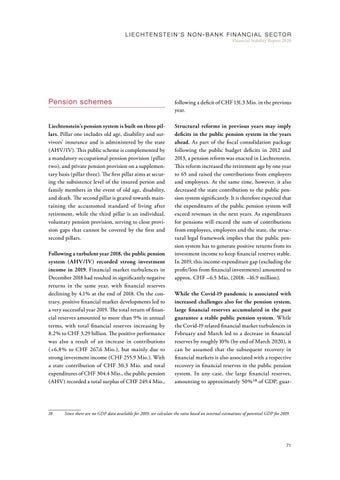LIECHTENSTEIN’S NON-BA NK FIN A NCIAL SECTOR Financial Stability Report 2020
Pension schemes
following a deficit of CHF 131.3 Mio. in the previous year.
Liechtenstein’s pension system is built on three pillars. Pillar one includes old age, disability and survivors’ insurance and is administered by the state ( A HV / I V ). This public scheme is complemented by a mandatory occupational pension provision ( pillar two ), and private pension provision on a supplementary basis ( pillar three ). The first pillar aims at securing the subsistence level of the insured person and family members in the event of old age, disability, and death. The second pillar is geared towards maintaining the accustomed standard of living after retirement, while the third pillar is an individual, voluntary pension provision, serving to close provision gaps that cannot be covered by the first and second pillars.
Structural reforms in previous years may imply deficits in the public pension system in the years ahead. As part of the fiscal consolidation package following the public budget deficits in 2012 and 2013, a pension reform was enacted in Liechtenstein. This reform increased the retirement age by one year to 65 and raised the contributions from employers and employees. At the same time, however, it also decreased the state contribution to the public pension system significantly. It is therefore expected that the expenditures of the public pension system will exceed revenues in the next years. As expenditures for pensions will exceed the sum of contributions from employees, employers and the state, the structural legal framework implies that the public pension system has to generate positive returns from its investment income to keep financial reserves stable. In 2019, this income-expenditure gap ( excluding the profit / loss from financial investments ) amounted to approx. CHF – 6.5 Mio. ( 2018: – 16.9 million ).
Following a turbulent year 2018, the public pension system ( A HV / I V ) recorded strong investment income in 2019. Financial market turbulences in December 2018 had resulted in significantly negative returns in the same year, with financial reserves declining by 4.1 % at the end of 2018. On the contrary, positive financial market developments led to a very successful year 2019. The total return of financial reserves amounted to more than 9 % in annual terms, with total financial reserves increasing by 8.2 % to CHF 3.29 billion. The positive performance was also a result of an increase in contributions ( + 6.8 % to CHF 267.6 Mio. ), but mainly due to strong investment income ( CHF 255.9 Mio. ). With a state contribution of CHF 30.3 Mio. and total expenditures of CHF 304.4 Mio., the public pension ( A HV ) recorded a total surplus of CHF 249.4 Mio.,
18
While the Covid-19 pandemic is associated with increased challenges also for the pension system, large financial reserves accumulated in the past guarantee a stable public pension system. While the Covid-19 related financial market turbulences in February and March led to a decrease in financial reserves by roughly 10 % ( by end of March 2020 ), it can be assumed that the subsequent recovery in financial markets is also associated with a respective recovery in financial reserves in the public pension system. In any case, the large financial reserves, amounting to approximately 50 % 18 of GDP, guar-
Since there are no GDP data available for 2019, we calculate the ratio based on internal estimations of potential GDP for 2019.
71

